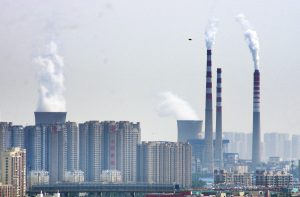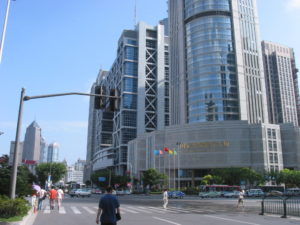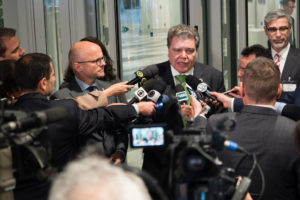The end of the year is traditionally the worst time for air pollution in northern China. But this year Beijing has enjoyed days of blue skies, with the winter outlook indicating the best air quality since 2013. Any celebrations though have been drowned out by huge controversies.
The resolute measures China has taken to ensure good air quality in 28 cities in northern China are causing others to complain of hardship. The policy of replacing coal with (less-polluting) natural gas requires millions of residents in Beijing, Tianjin and Hebei to stop using it. But progress has been patchy and in some places coal burning was banned before gas supplies were secured, leaving residents without fuel for heating – and in the harsh winters of northern China, this is causing suffering.
A more fundamental issue is the pressure on natural gas supplies caused by the new policy, with news of shortages and inconvenience still coming in.
Who is environmental protection for? For the city dwellers to enjoy clean air must villagers freeze? Questions such as these have spread on social media and for the first time the “class” aspect of environmental protection in China has been laid bare.
And this is not the only public dispute to arise over environmental protection. In September, German car component manufacturer Schaeffler took the unusual step of sending a letter to China’s environmental authorities, pleading for a supplier in Shanghai to be given more time. The supplier had been ordered to shut down for breaching pollution limits.
“Closing this factory will prevent the manufacture of 3 million cars and cause 300 billion yuan (US$ 45.6 billion) in economic losses,” Shaeffler said in the letter that was later leaked, stressing that the supplier’s products could not easily be replaced and the closure would impact on China’s entire vehicle manufacture supply chain.
Despite Schaeffler’s playing the economic card, the environmental authorities did not back down, directly accusing the German company of “not taking warnings seriously” at a press conference.
At the same event the Ministry of Environmental Protection rejected claims that protection efforts were pushing up raw material prices. It backed up that rebuttal with data showing that China’s economy is developing well and that rather than damaging growth, environmental protection is improving its quality.
With strong, top-level political support, and what looked like firm public backing, those responsible for environmental protection in China were not deterred by talk of new protections damaging the economy. But a few months later the controversy over the switch to gas caught them unawares. The ministry relaxed the schedule for the changeover in Beijing, Tianjin and Hebei, and Beijing took the unprecedented step of using back-up coal-fired power generators.
Consider that Beijing only shut down its coal-fired generators this year and not long ago bid an official farewell to coal-fired power.
Although the heating switch could be interpreted as environmental protection trumping concerns for vulnerable groups, others took a closer look: why had the technicians implementing the policy miscalculated rollout schedules and natural gas supplies? Had there not been a chance during the policymaking process for those technicians to express doubts, preventing a flawed policy from being forced through?
This year-end controversy shows that the ship of environmental protection, carried along by the winds of public opinion, and fanned by the “air apocalypses” of recent years, has run aground on hidden reefs of class tension and concerns around social justice.
Sweeping environmental measures are affecting the interests of more Chinese people. Closing a polluting factory may still win cheers, but making heating, cooking and driving more difficult are less popular.
Annual data also shows how China’s road to environmental protection will not be a straight one. After three years of falling, coal consumption rebounded this year. Although it is unlikely to return to the high of 2014 (some researchers think coal consumption in China will never reach 2014 levels again), coal consumption acts as a barometer for China’s environmental progress (on air pollution and climate change) and this year reminds us that while there are many positive signs, environmental improvements will not be solved until some deep-rooted problems are addressed.
As well as environmental controversies at home, 2017 saw subtle tensions develop between China’s environmental image at home and abroad. Whether it was Xi Jinping’s speech at Davos in January, or the report of the 19th Party Congress in the autumn, the signals were strong and clear: China is sticking to green development and its vision of an ecological civilization. But China’s overseas environmental footprint caused repeated controversy: China is slashing coal use and reducing pollution at home, so questions were asked about why it continues to finance and build coal-fired power stations overseas.
“China is not breaking the letter of its Paris commitments, but these Belt and Road investments are certainly not in keeping with the spirit of the agreement,” said Elizabeth Economy, a well-known expert on Chinese environmental issues, writing on Politico.
The seizure of a Chinese fishing vessel laden with sharks off the Galapagos Islands focused attention on China’s global environmental footprint. The crew of the vessel that caused the uproar were later jailed by the Ecuadoran authorities. With China’s coastal fisheries exhausted after decades of overfishing, China’s distant water fishing fleet is suspected of shifting the problem elsewhere.
Both at home and overseas there looked to be a “zero-sum” character to China’s environmental strategy. To achieve environmental aims benefiting one group, it seemed necessary to harm another. Whether that’s farmers in Hebei, or fishermen in the Americas. And the international context strengthened that sense of a zero-sum game.
In Trump’s first year as an “America First” president, he appointed a head of the Environmental Protection Agency who is opposed to environmental protection and announced America would withdraw from the Paris Agreement. The message from the Twitter-loving president is clear: At home, US environmental policy is damaging industry, while international environmental policy is damaging US interests as a whole.
Although there are no signs yet that China’s policymakers will follow in Trump’s footsteps, if the environmental tensions seen this winter continue then both their credibility and focus will be tested.
Online commentators are saying that a lack of transfer payments, both domestically and internationally, is causing tension between environmental protection and poverty.
Beijing residents benefit from environmental policy, but there is no system to compensate Hebei villagers left to pay the costs. Meanwhile, residents of poor countries who suffer when their development rights are curtailed for the sake of global emissions reductions have inadequate systems through which they can obtain financial support from richer nations.
In China, at this key stage of its energy revolution and construction of the ecological civilization, it is time to place the issue of fairness during the green transition on policymakers’ desks.








